David brings a very broad and varied set of experiences and interests to his artistic endeavors, and his work reflects this breadth. He is a thoughtful and thinking man, and, as Silver Falls and Whidbey Island participants can attest, he is an excellent teacher. It is great to have this opportunity to become better acquainted with this most interesting artist.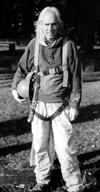
LE: To begin with, please introduce yourself.
DM: My name is David Preston Miller (I use my middle initial. As I grew up, being referred to in this fashion helped to distinguish myself from the other John Does). I was born in New Hampshire in 1949. I am the oldest of five children: two boys and three girls, with an age difference of sixteen years. I grew up, as I consider it, being a corporate nomad, as at that time the corporate structure for management required managers and their families to move often. I was always the “new kid on the block.” Four moves, four states by the eighth grade. I finished high school in a small western Pennsylvania coal-mining town. I probably have lived at fifty addresses since I was born. I have lived in the Northwest almost ten years. One year in Bellingham and the remainder outside of Marcola, Oregon on a dead-end road in an area of an early logging town named Wendling. I had spent most of my life in the Northeast, and I have only Alaska and Hawaii left as states to travel to.
LE: Tell us about your life history as it relates to being an artist.
DM: The constant in my early life was summer visits to New England to visit my grandparents. It was a world of no television, mountain climbing, hikes, organic gardening, theater, and classic literature in an area around Cornish, New Hampshire. This is in an area along the Connecticut River with Mt. Ascutney (an extinct volcano) on the horizon, and it is where St. Gaudens, Maxfield Parish and J.D. Salinger lived and worked. At the time, I was unaware of their eventual influence. During these visits, I would spend time at the museum in Hanover wandering through the collections, and I was also exposed to the paintings of George Tooker in the library.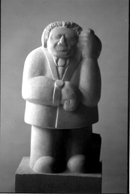
In high school, for some reason, I was not allowed into art classes. In college, I finally took art fundamentals and made my first sculptures. A design relief for a made-up movie opening and a 3D made-up animal evolved from environmental issues. During this time, I got a job in the library and in the process of cataloging so many subjects I came to feel that I had to experience more before deciding what to become.
At 19, I started a business with a partner and for about three years designed, made, wholesaled, and established a retail store with leather sandals, purses, clothing, and hard leather cases. Stemming from my first role as an Italian, mustached aristocrat in high school and a bald-headed priest in Roshomon in college, I became involved in some community theater and had roles as a singer in “Hair,” tap dancer in “Oklahoma,” and miscellaneous characters in experimental and seasonal productions. I also gained experience in set design, which may have helped in later hirings as a sculptural set designer.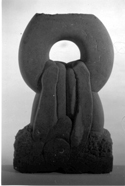
It wasn’t until 1974 that I made my first stone piece out of a found sandstone block from a vacant lot, which I carved with hardware store chisels and a few Sculpture House chisels. At this time I also found a source for soapstone scraps for small hand-sized pieces. This process set in motion a mostly self-taught direction in stone carving. About this time, I found a book by Mark Batten called “Stone Sculpture by Direct Carving” which helped a lot.
LE: Why did you become an artist?
DM: For years I resisted the responsibility of being an artist. That was what someone else did. “Becoming an artist,” I came to understand, was what I was doing, and if I did not let out the creative spirit that kicked inside me I was not whole. This was a means of making sense of my experience of being alive in the universe. Ending up with an artifact of that struggle was a reflection to see where it was and a guidepost of where to possibly go.
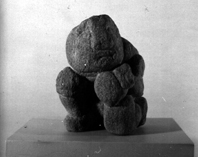
LE: Who or what influenced your art form?
DM: I am a child of the sixties in all that could mean. There was the threat of nuclear destruction and the exercises of hiding under your desk at school or against the wall, the corporate homogenization of life living in tract housing developments, yet hearing in the distance that life could be otherwise. Then there was Kennedy’s assassination, the Vietnam War, civil rights, the death of King, Malcolm X, another Kennedy, Chicago, Kent State, Black Panthers, psychedelic movement, riots, commodefication of alternatives, resistance to social change for the collective good, South and Central America, etc. etc.
I was influenced by the pop artists and sculptors such as Brancusi, Henri Gaudier-Brzeska, Eric Gill, Ivan Mestrvich, Henry Moore, William Edmondson, and Noguchi. I’ve always been drawn to a moving, elemental raw essence of energy. I must also mention Richard Diebekon as a “flat” artist whose Ocean Park series has always moved me.
LE: What key life experiences affected your direction in art?
DM: I remember seeing the Olmec show as a child. I think it was in Philadelphia, and I was in awe of the colossal heads. These may have been the first serious stone objects I observed. For two years I was a model for university art classes. This taught me structure from the inside out which one experiences standing for an hour or more in one position. This started me drawing and painting. I then went to South America for about four months and was exposed first hand to ancient cultures: visiting sites, ruins, museums; being around the rawness of volcanoes, dugout canoes at the head tributaries of the Amazon, with people who live close to the earth; a five-day trek to Machu Pichu on a road through the mountains and jungle; earthquakes, revolutions, etc. In other words, a deep exposure to the life force. I then spent time periodically in Mexico with the cultures of the Olmec, Mayan, Aztec, Toltec and their extensive stonework. I recognized that these were “my people.”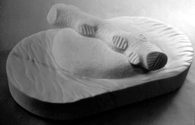
LE: How has NWSSA influenced your work as an artist?
DM: It has provided me with an opportunity to be exposed to others in their struggles with stone. After years of working and thinking in an isolated fashion, it has given me access to a tribe of like-minded individuals with whom to share enthusiasms and possibilities. It has also given me a chance to articulate presentations for others to consider through a teaching venue.
LE: How and where do you get your ideas?
DM: Music, driving, walking city streets and wilderness trails, and shadows all seem to be important starting places. It is during these moments that ideas seem to flood forth and, if I am fortunate enough, I am able to write down some aspects of these experiences. Also, when I see other artist’s work it is the parts of their work that sync with my creating at the time. Example: Edward Hopper’s work has pulled me in for decades. The last few years I have been intrigued with abstracting from each work some small section to translate in a 3-D rendition.
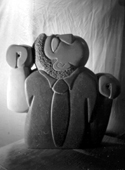
LE: What is the source of inspiration of your forms – language or imagery?
DM: Feeling – communication. Sometimes I respond to the stone when I see something that reminds me of the stacks of ideas I carry. Hmm,–what arrives first, the image or the language? Good question. They are always flipping about. I’d say a split. I have a sculptor friend who gives his students Italio Calvino to read to make a piece of work. I have found that inspirational. Poetry jogs my mind into another plane to proceed from. I also periodically read physics and advanced math texts to dislodge myself to an unknown place, because I do not understand what I read. The structure created allows me to see differently, as if that gets me out of the way to let a new way in.
LE: What are you trying to express?
DM: Feelings: the solidification of the intangible nature of feelings so that I can physically reflect on them. To give form to things that seem intangible I look at my pieces as sentences, paragraphs – it is my journal, my stone tablet. For me it has been my personal journey, a record of my own struggle; how to manifest the spirit in the material world.
LE: Please describe a few recent pieces.
DM: “The Nature of Nature – Fragment One” – This is a lozenge-shaped Colorado yule marble piece. It is an extraction of a scene from nature. It shows the surface of a stream with a stone protruding from the water. A chewed beaver stick is balanced on the top of the rock. I see it as a still life – it was a challenge of a frozen moment of textures – how to stop water.
I am trying to finish a Danby Marble piece from Vermont that is a portrait of a macaroni noodle balanced on a ball. This is about four feet tall. What? An absurd reference to the fundamentals of life – the preciousness of marble and the common struggle for nourishment.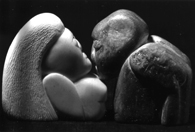
Also, I was asked in the last year to get involved in the restoration of a vandalized Civil War statue dating from 1906. The head was knocked off and was missing, so they wanted to have a replacement made.
LE: What do you like about them?
DM: In the “Nature of Nature” piece, I liked that it worked since I had attempted the same piece three years before in Vermont marble and the material failed (or my approach was misdirected) when it was 80% done. I was discouraged. The noodle piece I enjoyed for the challenge of the simplicity in such a large format. The replacement head was a wonderful way to apply my passion to a project that helped the larger community heal itself, as this statue was a neighborhood landmark as well as an historic artifact. I might elaborate a bit on this.
The veteran lived the end of his life in Eugene and left a sum of money in his will to provide a resting place for any veteran of the Civil War to be buried here. Distant relatives appeared over night to contest the will, and the court ruled in the deceased’s favor. A statue was ordered from Proctor, Vermont, shipped by train, and met by horse and wagon. The grandfather of the present secretary of the cemetery installed the statue, and twenty some veterans have found a spot of rest here. The legacy is still connected emotionally to the living. My postmistress’s husband grew up next to the cemetery, and the bill of the cap of the statue has been broken off for his entire life.
LE: What was involved in creating these pieces?
DM: The yule piece was primarily done with power tools with a hand finish ending. The challenge was to orient the image to the bedding plane so that the stick resting on the rock did break off. This type of marble has a very distinct layered order of deposit. One way it is very strong and in the other direction it exfoliates. It takes a beautiful finish.
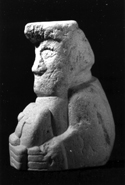
The noodle was done primarily with hand tools and I then used power tools to finish the surface. In the use of hand tools, I wanted to imprint my brain with the challenge of arriving at the form through the slow struggle of the point which I felt would give me a deeper understanding of the progress of form development. That is, to keep the form on track and not distorting or twisting out of control, one point at a time. I feel this adds to a greater understanding of the planes in relationship to the space they occupy and define.
The replacement head was made of blue-grey marble from Vermont called Mississippi grey. I wondered if this was chosen to represent both sides of the war. Maybe it was just serendipity. The nature of this stone consists of bedding planes with fine grain particles interspersed which complicated the procedure. I found I had to approach the roughing out phase with power tools and it challenged me to think in the circular approach of the blades and grinders. Later I was able to use pneumatic chisels and then hand tools at the end. This made me respect those who had done this on the original and realize how much technique there is to be learned or discovered in order to be preserved. The final image had a modern feel that I felt paralleled the original style but did not fully hide the fact of its restoration. It also brought the present into the image of honoring those who had chosen or been chosen to fight in this way while not glorifying war. An additional challenge involved the use of a 3 x 5 photo of this sixteen-foot statue.
LE: What stones do you prefer?
DM: Limestone. The reason I love limestone is that I like the quality of the neutral color. For me, it is about shadows, not about light. I recently had a conversation with Sabah al-Dhaher, and he reminded me about the nature of marble and its ability to mimic other materials depending upon one’s finish. This is what I discovered in the “Nature of Nature” piece, and I look forward to exploring this aspect further in this material.
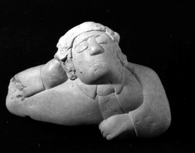
LE: What is your working process – do you do one piece at a time or do you have several pieces going at once?
DM: If I am fortunate enough, I have one piece that I can follow through on. Generally, I have a progressive line of pieces asking to be finished.
LE: What tools do you use?
DM: Primarily, I have used hand tools because they keep me in close proximity to the relationship with the idea, the stone, and the present moment; the metaphor of the focus of the point, that has been important to me. Last year I did a piece with basically all power tools, except for hand finishing, because the nature of the stone demanded roughing out with power tools. I see this as preparation for attempting work in harder stone such as granite.
LE: Do you exhibit your work?
DM: In the last ten years I have been somewhat obscure and have exhibited in a group show about one piece a year, it seems.
LE: How much work do you complete in a year?
DM: Maybe three pieces a year. I am always striving to have more carving time and the more I focus on it the more I complete.
LE: Do you teach?
DM: Yes. In the early 90’s I helped reestablish the stone carving classes at the Pittsburgh Center for the Arts, in Pennsylvania. In the past several years I have been teaching at the Emu Craft Center at the University of Oregon Fall and Spring terms (four six hour Saturdays). For the last seven years I have participated in the University’s marble workshop as an invited artist. I did a presentation at Silver Falls for two years. Most recently I participated in the hand-carving workshop on Whidbey Island with Suz Gentiluomo. I have also been a mentor to a few people in the introduction to stone.
LE: In what scale or size do you work?
DM: As big or small as my budget or opportunity allow.
LE: Do you have a favorite scale?
DM: Each vision comes with its own size – it depends which get realized. I would like to work larger but no larger than human size.
LE: How is your work area set up?
DM: My studios have been varied. I have worked in corncribs, garden sheds, garages, factories with overhead cranes and forklifts, on tops of smokestacks, basements – the point is I work wherever I can. Ideally I like working outdoors, and I like having an indoor space for the more delicate aspects and seeing the piece in an isolated interior format.
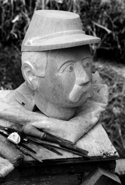
LE: What have been your satisfactions in your life as an artist?
DM: The privilege to pursue creativity.
LE: What obstacles and challenges have you overcome?
DM: None – it is always my struggle. Each time it is a new struggle or a different angle of an old struggle: “The Blank Canvas.”
LE: What are you looking forward to?
DM: An opportunity to work everyday on carving stone.
Finally I just want to say: I see stone as the essence of life dissolved in particles small enough for me to carry. The ancients, the ancestors of the world who have worked with stone as a way to express humanity speak through me. As a modern person I resist and must learn to hear them. When you see a stone in place you know that our experience is the same as the one who put it there. They were confronted with the same challenges that you are. If there is a world of the soul, there is a possible guidance. Using stone as a medium of expression, I am one of the messengers. We came from dust and return to dust. Did it choose me; did I choose it? It does not matter; it speaks through me.

